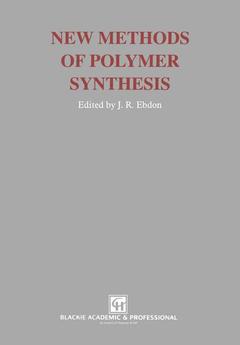New Methods of Polymer Synthesis, Softcover reprint of the original 1st ed. 1991
Langue : Anglais
Auteur : Ebdon J.R.

Most practitioners and students of polymer chemistry are familiar, in general terms at least, with the established methods of polymer synthesis - radical, anionic, cationic and coordination addition polymerization, and stepwise con densation and rearrangement polymerization. These methods are used to synthesize the majority of polymers used in the manufacture of commercially important plastics, fibres, resins and rubbers, and are covered in most introduc tory polymer chemistry textbooks and in most undergraduate and graduate courses on polymer science. Fewer polymer chemists, however, have much familiarity with more recent developments in methods of polymer synthesis, unless they have been specifically involved for some time in the synthesis of speciality polymers. These developments include not only refinements to established methods but also new mechanisms of polymerization, such as group transfer and metathesis polymerization and novel non-polymerization routes to speciality polymers involving, for example, the chemical modification of preformed polymers or the linking together of short terminally functionalized blocks.
1 Developments in polymerization.- 1.1 Introduction.- 1.2 Radical addition polymerization.- 1.2.1 General features.- 1.2.2 Iniferters.- 1.2.3 Template polymerization.- 1.2.4 Ring-opening polymerization.- 1.2.5 Copolymerization.- 1.3 Ionic and coordination addition polymerization.- 1.3.1 General background and developments.- 1.3.2 Living anionic homo-and copolymerization of oxiranes.- 1.3.3 The activated monomer mechanism of oxirane polymerization.- 1.3.4 Living carbocationic polymerization of vinyl ethers.- 1.4 Stepwise polymerization.- 1.4.1 General background.- 1.4.2 Aromatic polyesters and polyamides.- 1.4.3 Polysulphones and polyketones.- 1.4.4 Starburst polymers: dendrimers and arborols.- 1.4.5 Biosynthetic routes to polymers.- References.- 2 Group transfer polymerizations.- 2.1 Introduction.- 2.1.1 Background.- 2.1.2 Terminology.- 2.1.3 Nucleophilic addition.- 2.1.4 Silyl ketene acetals.- 2.2 Features of group transfer polymerization.- 2.2.1 General features.- 2.2.2 Reaction conditions.- 2.2.3 Initiators.- 2.2.4 Catalysts.- 2.2.5 Monomers.- 2.2.6 Termination.- 2.2.7 Polymer microstructures.- 2.3 Kinetics and mechanism.- 2.3.1 Polymerization of methacrylates.- 2.3.2 Polymerization of acrylates.- 2.4 Aldol group transfer polymerization.- 2.5 Copolymers.- 2.5.1 Random copolymers.- 2.5.2 Block copolymers.- 2.5.3 Coupling.- 2.5.4 Other routes.- 2.6 Telechelics.- 2.7 Related and anionic polymerizations.- 2.8 Applications.- References.- 3 Ring-opening metathesis polymerization of cyclic alkenes.- 3.1 Scope of ring-opening metathesis polymerization.- 3.2 Monomers for ring-opening metathesis polymerization.- 3.3 Catalysts for the ring-opening polymerization of cycloalkenes.- 3.4 Mechanism of ring-opening metathesis polymerization.- 3.4.1 Site of olefin metathesis.- 3.4.2 Pairwise mechanisms.- 3.4.3 Non-pairwise mechanisms.- 3.4.4 Metallocyclobutanes.- 3.4.5 Transition metal carbenes.- 3.5 Molecular weight distribution in polyalkenylenes.- 3.6 Stereochemistry of ring-opening metathesis polymerization.- 3.6.1 Stereoisomerism of polyalkenylenes.- 3.6.2 Stereoisomerism in norbornene polymers.- 3.6.3 Substituted norbornenes.- 3.7 Thermodynamics of ring-opening polymerization.- 104 References.- 4 Transformation reactions.- 4.1 Introduction.- 4.2 Historical development of transformation reactions.- 4.3 Transformations between anionic and cationic polymerization.- 4.3.1 Anion to cation transformations.- 4.3.2 Cation to anion transformations.- 4.3.3 Anion to cation coupling reactions.- 4.4 Transformations between ionic and free radical polymerization.- 4.4.1 Anion to radical transformations.- 4.4.2 Cation to radical transformations.- 4.4.3 Radical to ionic transformations.- 4.5 Transformations involving other modes of polymerization.- 4.5.1 Anion to Ziegler-Natta transformations.- 4.5.2 Anion to metathesis transformations.- 4.5.3 Ziegler-Natta to radical transformations.- 4.5.4 Group transfer to radical transformations.- 4.5.5 Metathesis to aldol-group transfer transformations.- 4.5.6 Radical to active monomer transformations.- 4.5.7 Transformations between radical polymerization and polypeptide synthesis.- 4.6 Conclusions.- References.- 5 Chemical modification of preformed polymers.- 5.1 Introduction.- 5.2 Chemical reactions of polymers: general aspects.- 5.3 Modification of polymers.- 5.3.1 Modifications on the polymer main chain.- 5.3.2 Modifications of pendant groups.- 5.3.3 Miscellaneous systems.- 5.3.4 Concluding remarks.- References.- 6 Terminally reactive oligomers: telechelic oligomers and macromers.- 6.1 Introduction.- 6.2 The synthesis of terminally reactive oligomers.- 6.2.1 By anionic polymerization.- 6.2.2 By group transfer polymerization.- 6.2.3 By cationic polymerization.- 6.2.4 By radical polymerization.- 6.2.5 By stepwise polymerization.- 6.2.6 By controlled polymer chain scission.- 6.2.7 Modifications of end-groups of telechelic oligomers.- 6.3 Reactions and reactivity of telechelic oligomers and macromers.- 6.3.1 Telechelic oligomers.- 6.3.2 Macromers.- 6.4 Uses of terminally functionalized oligomers.- 6.4.1 Telechelic oligomers.- 6.4.2 Macromers.- References.
Date de parution : 04-2012
Ouvrage de 208 p.
17x24.4 cm
Disponible chez l'éditeur (délai d'approvisionnement : 15 jours).
Prix indicatif 52,74 €
Ajouter au panierThème de New Methods of Polymer Synthesis :
Mots-clés :
Rearrangement; plastics; polymer; polymer chemistry; polymer science; polymer synthesis; polymerization; polymers; synthesis
© 2024 LAVOISIER S.A.S.



